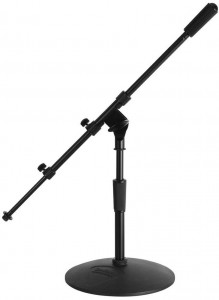My Favorite Kick Drum Mic Stands
After years of recording and doing live sound, I’ve discovered that buying a mic stand for your kick drum is NOT where you should try and save some money. It’s just not worth it. A cheap stand will be tipping and slipping until you’re ready to pull your hair out. You’ll try all kinds of creative hacks involving duct tape, string, and sandbags to prevent it, only to have it happen again in the middle of a session or live gig. With that being said, I’d like to recommend a couple of specific mic stands that should serve you well in this application.
First is the DMS7E Low Profile Mic Stand from Atlas Sound. This is the stand that I personally own and use (I actually own two of them). It has a height adjustment range of 8″ to 13″, which (combined with a boom arm) works well for miking most kick drums. With its heavy weight (7.3 lbs without a boom) and full-sized 10″ round base, it won’t tip over with even the longest of booms or heaviest of bass drum mics. The clutch assembly for the height adjustment is also very sturdy, and won’t easily slip. This stand is basically a standard round base mic stand, but it’s just really short! The only down-side to this one is that it doesn’t include a boom arm, which is pretty much a must-have for miking a kick drum, so that will cost you extra. Atlas also makes a slightly taller version of this stand (the DMS10E), but just like the DMS7E, it does not include a boom, so you’ll have to add your own.
My next recommendation is the MS9409 Pro Kick Drum Mic Stand from On Stage Stands. This stand (which wasn’t on the market when I bought my Atlas stands) boasts a height adjustment range from 9″ to 13″ and also has an oversized 10″ round base. It includes a telescoping boom arm that adjusts from 21.5″ to 36″, and the boom has a removable counterweight. With the counterweight removed, you can actually mount a second mic on that end of the stand (more about that later). I haven’t tried this particular stand yet, but it looks like a worthy contender, since it compares favorably with the Atlas: the size and weight are the same, the price is the same, and it includes a boom arm which you’ll have to purchase separately for the Atlas. I’ve also owned and used many other stands from On Stage and have had good luck with them–I even use a couple of their boom arms with my own Atlas stands (since they weren’t included).
Also worth mentioning is the “big brother” to this stand, the On Stage MS9417. It’s just like the MS9409 except for the taller height of the lower base section of the stand, which can be adjusted from 17″ to 28.5″. This height makes it ideal for miking snare drums, floor toms, guitar/bass cabinets, and acoustic guitars for seated performers. It also includes the same boom arm with removable counterweight as its smaller sibling. Like I mentioned earlier, with the counterweight removed, you can mount a second mic on the butt-end of the boom, which opens up some interesting possibilities for dual-mic setups, like maybe using a large-diaphragm condenser on the body and a small-diaphragm condenser on the neck of an acoustic guitar–using a single stand for both mics. Another interesting dual-mic technique would be using one stand with the boom in a T-formation for miking two floor toms. You could also use this slightly taller version for miking some bass drums: from outside the front head, or from the inside–if the hole is cut high enough or there’s no front/resonant head installed on the drum.
Don’t get me wrong. I’ve used other tripod-leg stands and stands with a funky-shaped cast-iron bases (such as this one) that are supposed to be designed for miking a kick drum. Some of them worked better than others, but most required me to position the boom arm and mic in a particular way to prevent tipping. But even with careful positioning, they could could still tip over if the stand was bumped, the boom arm was over-extended, or the mic being used was very heavy (e.g. the Sennheiser e602). But I’ve never had these problems since making the switch to the stands with the full-sized round base. So do yourself a favor, save yourself some headaches, and invest in a good stand to use for your kick drum mic. It’s worth it.
 September 27, 2019
|
Posted by Jon (admin)
September 27, 2019
|
Posted by Jon (admin)

 Categories:
Categories:  Tags:
Tags: 